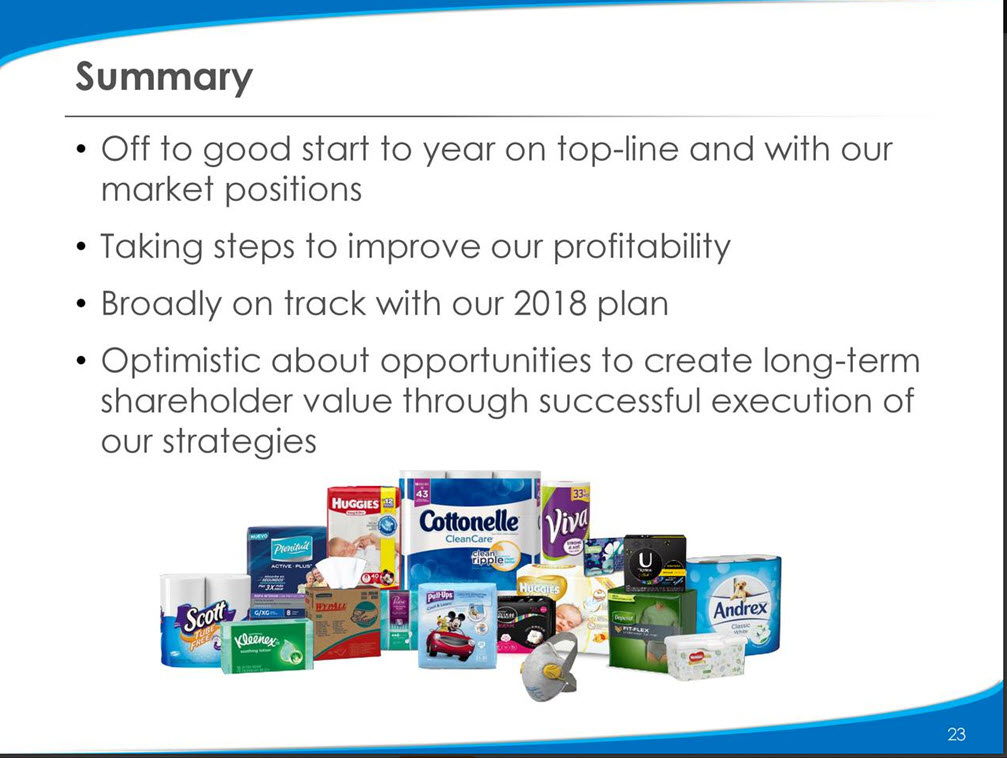Introduction
In part 1 found here of this multi-part series I discussed how several blue-chip dividend growth stocks have already entered a bear market.
Therefore, I thought it would be helpful to provide FAST Graphs analyze out loud videos on several dividend growth stocks that have corrected from high valuation levels to more reasonable levels. My first research candidate was General Mills Inc (GIS), with this article I will be covering Kimberly-Clark (KMB). The following slide summarizes their key product lines. And the second slide highlights management’s optimism about the future growth potential of the company.


FAST Graphs Analyze out Loud Video: Kimberly-Clark
Kimberly-Clark’s stock price has fallen more than 20% since February 2017. However, as I intend to illustrate in the following analyze out loud video, nothing fundamentally has really changed with the company. I made a similar statement when I presented General Mills in my previous article and received some pushback in the comment thread. Consequently, I offer the following clarification that might help readers and viewers understand what I’m suggesting.
In 2016, Kimberly-Clark was extremely overvalued, and it entered 2018 still overvalued but not at the extreme level it was in 2016. Thanks to the correction, this quality consumer staples company now offers investors a dividend yield exceeding 3.8%. But most importantly, growth expectations going forward are more of the same and consistent with the company’s historical achievements.
On the other hand, this is not the same as saying that every year will be the same as every other year. That is rarely if ever true with any company. Although Kimberly-Clark is far from what I would classify as a cyclical company, it does have years where operating performance is better than others and years when it is worse. That is normal and is very unlikely to change with a consumer staples company like Kimberly-Clark. Therefore, and to clarify, market value has changed dramatically over the last couple years but the company’s intrinsic value remains at historical norms.
Summary and Conclusions
Kimberly-Clark is a blue-chip dividend growth stock and Dividend Champion that has increased its dividend for 46 consecutive years. As such, I offer it as a dividend income option and not necessarily as an opportunity to beat the market. This idea that every stock must beat the market is one that I find quite naïve. Investors invest in fixed income investments such as CDs and bonds without any expectation or goal of beating the market. Instead, they invest in these instruments because of their safety and the opportunity to generate a reliable income stream.
Nevertheless, in the case of Kimberly-Clark, I am quite confident that it will produce a greater level of dividend income than the market. Moreover, if purchased at an attractive valuation, it is also likely to produce a respectable level of capital appreciation. As it is with most research candidates that I offer, it’s up to the individual reader to decide whether or not the candidate meets their own personal goals, risk tolerances and objectives.
In my next article, Part 3, I will cover 3M, a Dividend Champion and Dividend Aristocrat that has increased its dividend for 60 consecutive years.
Disclosure: Long KMB.
Disclaimer: The opinions in this document are for informational and educational purposes only and should not be construed as a recommendation to buy or sell the stocks mentioned or to solicit transactions or clients. Past performance of the companies discussed may not continue and the companies may not achieve the earnings growth as predicted. The information in this document is believed to be accurate, but under no circumstances should a person act upon the information contained within. We do not recommend that anyone act upon any investment information without first consulting an investment advisor as to the suitability of such investments for his specific situation.